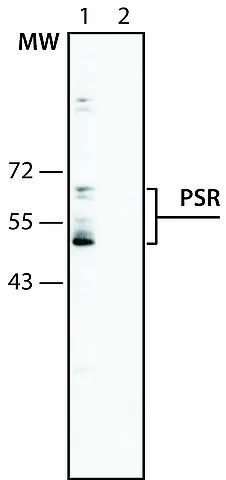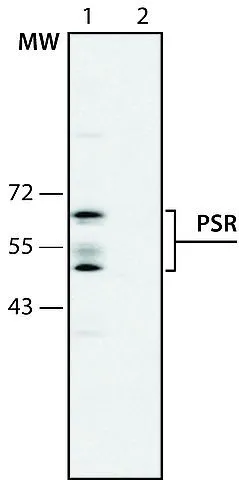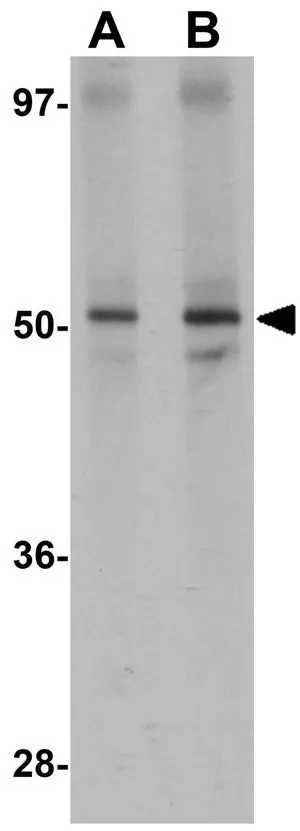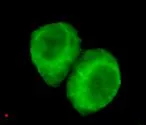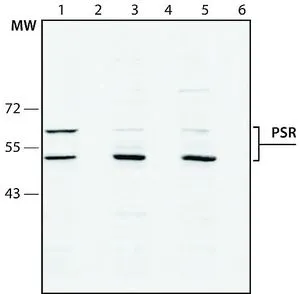
WB analysis of (Lane 1- 2) HeLa, (Lane 3 -4) Jurkat, (Lane 5- 6) Molt-4 cell lysate using GTX10526 PSR antibody. Lane 1,3,5:. Antibody 1 microg/mL Lane 2,4,6: Antibody 1 microg/mL + PSR immunizing peptide
PSR antibody
GTX10526
ApplicationsImmunoPrecipitation, Western Blot
Product group Antibodies
ReactivityHuman, Mouse
TargetJMJD6
Overview
- SupplierGeneTex
- Product NamePSR antibody
- Delivery Days Customer9
- Application Supplier NoteWB: 1:500~1:1000. *Optimal dilutions/concentrations should be determined by the researcher.Not tested in other applications.
- ApplicationsImmunoPrecipitation, Western Blot
- CertificationResearch Use Only
- ClonalityPolyclonal
- Concentration1-1.5 mg/ml
- ConjugateUnconjugated
- Gene ID23210
- Target nameJMJD6
- Target descriptionjumonji domain containing 6, arginine demethylase and lysine hydroxylase
- Target synonymsPSR, PTDSR, PTDSR1, bifunctional arginine demethylase and lysyl-hydroxylase JMJD6, arginine demethylase and lysine hydroxylase, histone arginine demethylase JMJD6, jmjC domain-containing protein 6, jumonji domain-containing protein 6, lysyl-hydroxylase JMJD6, peptide-lysine 5-dioxygenase JMJD6, phosphatidylserine receptor
- HostRabbit
- IsotypeIgG
- Protein IDQ6NYC1
- Protein NameBifunctional arginine demethylase and lysyl-hydroxylase JMJD6
- Scientific DescriptionMost cells that undergo apoptosis are rapidly recognized, engulfed, and digested by professional phagocytes or by neighboring cells and eliminated from the organism. In this way, tissue exposure to potentially cytotoxic, immunogenic, or inflammatory cellular contents is prevented. As a result neither inflammation nor inappropriate immune responses are induced in this process. Removal of apoptotic cells comprise the following steps: surface alteration and ligand expression on the apoptotic cell, ligand recognition by tethering receptors on the phagocyte, initiation of appropriate signaling pathways in the phagocyte, engulfment and finally, digestion. Various molecules including proteins, carbohydrates, and phospholipids have been suggested to act as cell surface exposed markers for recognition by phagocytes. Virtually all apoptotic cells permanently express phosphatidylserine (PS) on the outer leaflet of their plasma membrane. Such loss of phospholipids asymmetry and exposure of PS does not occur in resting cells and appears only transiently following activation of certain cells. Phosphatidylserine Receptor (PSR) has been reported and shown to recognize phosphatidylserine in a stereospecific manner. PSR is an evolutionarily conserved glycoprotein that is widely expressed in cells and tissues. It is very susceptible to cleavage by protease or elastase. PSR engagement plays an important role in macropinocytosis and uptake of tethered apoptotic cells. Cooperation with other receptors and their ligands may also be needed for ingestion of apoptotic cells. PSR is also involved in suppression of inflammatory and immune responses.
- ReactivityHuman, Mouse
- Storage Instruction-20°C or -80°C,2°C to 8°C
- UNSPSC12352203

